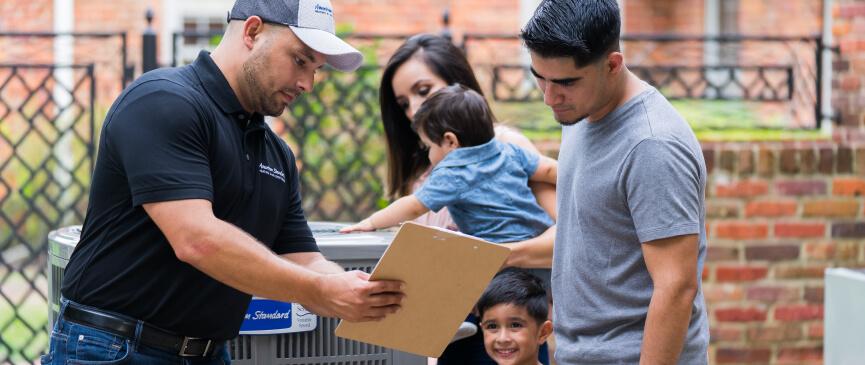How Ceiling Fan Direction Can Impact Your Energy Bills
Find out why ceiling fan direction is important, which direction the fan should go in summer vs winter, and how to change ceiling fan direction to save on your energy bills.

By Anne Fonda
If you have ceiling fans, you probably turn them on when the kitchen gets warm or on the first warm night of summer. But did you know you can use your ceiling fans year-round? While it might sound odd to use a fan in the winter, when done right, it can help you feel warmer without cranking the heat.
Understanding the relationship between ceiling fan direction and home comfort
Video courtesy of Citizens Utility Board
Ceiling fans move air, making you feel cooler or warmer, based on the direction of the fan. They do not change the temperature of the room. When you use one or more ceiling fans, you can increase home comfort while reducing energy usage.
In the summer, the breeze from a ceiling fan creates a wind chill effect. According to the Department of Energy (DOE), this feeling of cooler air can allow you to set your thermostat 4 degrees higher. In the winter, a ceiling fan can help redistribute warm air that has collected near the ceiling, making you feel warmer. This allows you to set the thermostat lower.
To reap the energy-saving benefits a ceiling fan can provide, learn the specifics about ceiling fan direction and air movement.
Counterclockwise is the direction a ceiling fan should be set in summer. When the ceiling fan blades move counterclockwise, they create a downdraft, which feels like a cool breeze. Use higher fan speeds in the summer to increase the wind chill effect.
The right summer ceiling fan direction can help keep you cool on hot summer nights. If you tend to get hot when you sleep, keep the summer fan direction setting for most of the year. By using ceiling fans strategically, you can cut your air conditioning costs.
Your winter fan direction should be clockwise. When the fan blades move clockwise, they create an updraft, pulling cold air from the floor level upwards and mixing it with the warm air trapped at the ceiling level and sending this mixed air back down into the room. Use a lower fan speed in winter to gently circulate warm air without creating a breeze.
Setting the right fan direction in winter is important if you want to use ceiling fans to help keep your family warm without raising the temperature on the thermostat.
Changing the ceiling fan direction for winter or summer is fairly easy and consistent for each ceiling fan in your home. Here’s how:
- Turn the fan off and allow the blades to stop turning.
- Look for a small sliding switch on the fan motor housing.
- Slide the switch to the opposite side of where it currently sits.
- Turn the ceiling fan back on, and the blades should be moving in the opposite direction of what they were.
- Refer to the manufacturer’s paperwork that came with the fan for more information.
If your fan has a remote control, turn off the fan. Push and hold the button that will change the fan's direction. You may need to refer to your owner’s manual if you’re not sure which button does that. If you have a smart fan, you may be able to use an app or a voice assistant such as Alexa or Google Home to make the change.
Since ceiling fans don’t heat or cool a room, turn them off when no one is in the room or no one is home. For example, you may want the fan on in the bedroom when you’re sleeping or getting ready for work. But when you leave the room, turn the fan off. While ceiling fans don’t use a lot of electricity, turning them off when they’re not needed can help you save further on your energy bills.
While it’s off, take a moment periodically to dust the ceiling fan. The blades collect dust and can send it spinning into the room the next time you start it. This is especially important in rooms where the ceiling fan doesn’t get much use.
If you don’t currently have ceiling fans, you may want to consider installing some in bedrooms and if you have a vaulted or cathedral ceiling. Look for ENERGY STAR®-certified ceiling fans to get the most comfort for the least amount of energy. Ceiling fans that have earned the ENERGY STAR® label are up to 40% more efficient than other fans.
Purchase ceiling fans sized for your room. Product listings will describe how many square feet a fan is suited for. Fans with longer blade spans of 52” or more move more air and may be suitable for a vaulted ceiling or cathedral ceiling or at the top of a stairwell.
Ceiling fans with shorter blade spans of 36” are better suited for smaller spaces such as bedrooms. Rooms with lower ceilings will need flush-mounted fans while higher ceilings may require an extension rod.
For ceiling fans that are mounted higher up, consider models with a remote control so that you can easily switch fan direction without climbing a ladder to toggle a switch.
Being able to raise or lower the temperature at the thermostat while maintaining the same level of comfort is good for your wallet and good for the planet.
To keep your energy costs from going through the roof, keep your HVAC system running at peak performance. In addition to regularly changing the air filters, schedule a fall furnace or heat pump tuneup and a spring air conditioner or heat pump tuneup.
Your American Standard HVAC technician will inspect and clean the system, and test it to ensure it’s running properly. Regular maintenance can help you save money because your system runs more efficiently. It can also help prolong the life of your system.
Anne Fonda, Content Writer
A Content Writer with Trane Technologies, Anne Fonda researches topics and writes for Trane® and associated residential HVAC brands. She works in collaboration with Trane Technologies subject matter experts, offering easy-to-understand, informative content on complex topics. Her goal is to help consumers make informed decisions on the products and services they need.
She has written for HVAC and other service provider websites for over 16 years. Before transitioning to web content writing, Anne had a 14-year stint as an award-winning journalist. She graduated cum laude from the University of Missouri-Columbia School of Journalism.
When she’s not working, Anne enjoys playing word games, reading, gardening, spending time with family, and visiting gardens and museums.



